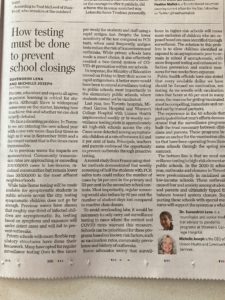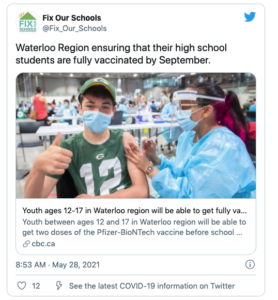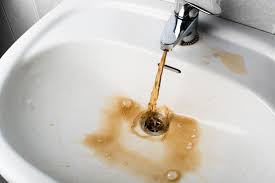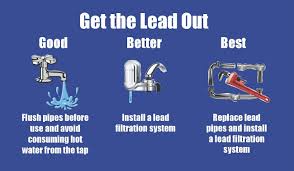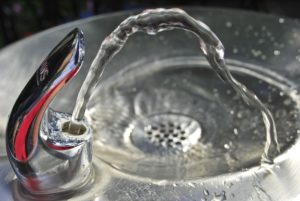Earlier in February, the Canadian Centre for Policy Alternatives (CCPA) released a thoughtful report entitled, “Catching Up Together: A Plan for Ontario’s Schools“, written by Ricardo Tranjan, a CCPA Ontario political economist and senior researcher; Tania Oliveira, an assistant economist with the office for the writing of this report; and Randy Robinson, the CCPA Ontario Director. The report presents an analysis of how the COVID-19 pandemic has impacted the 2-million children who attend publicly funded schools in Ontario, considering both pre-pandemic and pandemic educational inequality. The authors note that, “the pandemic has been hard on all students, but not all students have had the same experience. Households with higher incomes and more resources have, on the whole, managed to manage. Households with lower incomes and fewer resources have had a much more difficult time. Socioeconomic status has always affected educational outcomes, but COVID-19 has magnified differences.”
CCPA RECOMMENDATIONS
The CCPA report goes on to outline recommendations for how our provincial government should approach schools and education in the coming years to address these impacts. A 13-point plan is presented that would help students catch up during, and after, the COVID-19 pandemic. This proposed plan includes the following recommendations, which would directly impact school infrastructure, and so are of particular interest to the Fix Our Schools campaign:
1. Create a transparent state-of-good-repair criteria for assessing schools, and make the information publicly available on an ongoing basis
The CCPA report emphasizes that portables and schoolyards are not assessed and, therefore, the conditions of these aspects of school infrastructure are not included in the overall $16.8-B repair backlog in Ontario’s schools. The report cites the Fix Our Schools campaign when noting that many other aspects of school infrastructure are not included in the $16.8-B repair backlog, and therefore not measured or addressed, including:
- indoor air quality and ventilation
- quality of drinking water due to old lead pipes
- asbestos
- dampness/mold
- classroom temperatures, which are often too hot to learn in in the spring and fall and too cold to learn in in the winter months
2. Increase provincial funding for school maintenance from $1.4-B/year to $2 billion/year, an annual increase in provincial funding of $640-M
According to industry standards, funding for ongoing renewal of school infrastructure should be between 2% and 4% of the replacement value of the physical assets, and Ontario’s Financial Accountability Office (FAO) has estimated the replacement value of schools to be $68.1-B in 2020. Indeed, this industry-accepted standard was key to Fix Our Schools achieving an increase in provincial funding for school maintenance from $150-M/year in 2014 to $1.4-B/year in 2016. The $1.4-B represented an annual investment in Ontario’s schools of 2% of the replacement value of the schools, the absolute minimum requirement.
Since the time that our provincial government increased funding for school repair and renewal to this new $1.4-B level in 2016, we have continued to see yearly increases in the repair backlog in Ontario’s schools. This suggests that more annual funding is needed for school boards to reasonably be able to keep schools in good condition.
The CCPA report suggests that increasing annual investments in school maintenance to 3% of the replacement value of Ontario’s school would be a reasonable mid-point of the industry standard. This would mean the province should be spending $2-B/year on ongoing maintenance. “At current levels of provincial funding, the school repair backlog of $16.8 billion will continue grow, putting at risk the health of students and education workers, and creating ever-growing financial liabilities for school boards.”
3. Address the $16.8 billion repair backlog within the next 10 years by investing an additional $1.7-B/year in school infrastructure
Using the low-end of the industry standard for determining annual investment in maintenance of Ontario’s school infrastructure was clearly inadequate. Furthermore, our provincial government never acknowledged or made up for the almost 20 years of chronic and gross provincial underfunding that had allowed for $15-B of disrepair to accumulate in Ontario’s schools as of 2016. So, at the time that our provincial government increased annual funding for school maintenance to the lowest end of the industry-accepted standard, Fix Our Schools predicted that, without additional funding to address the $15-B of disrepair, Ontario would never dig its schools out of the pit of disrepair.
The recent CCPA report supports this prediction, and suggests that an additional $1.7-B/year in provincial funding is needed to address the $16.8-B repair backlog that exists in Ontario’s schools as of June, 2021.
“In 2002, the Education Equality Task Force estimated the repair backlog of Ontario schools to be $5.6-B. In June 2021, it stood at $16.8-B. How did that happen? The short answer: year after year, provincial governments decided not to take care of the buildings in which two million children and youth and hundreds of thousands of education workers spend most of their day. Poorly maintained infrastructure deteriorates faster and it becomes more expensive to repair.”
To create a state-of-good-repair that includes portables, schoolyards and aspects of school buildings currently not considered such as indoor air quality and classroom temperatures; to do the work to ensure those standards are met; and to collect data to ensure those standards are actually being met, it is essential that our provincial government deliver stable, adequate funding to school boards.  The total annual cost of the solutions proposed by this most recent CCPA report to improve school infrastructure in Ontario is $2.3-B/year. Interestingly, a 2017 CCPA report proposed many similiar ideas to improve Ontario’s school infrastructure and estimated that an additional $1.7-B/year provincial investment in school infrastructure was needed. It seems that the longer we wait to invest what is actually needed to ensure that Ontario’s publicly-funded schools are safe, healthy, well-maintained environments – the more and more expensive it will become to address this large and growing problem. So, without a doubt, as we emerge from the COVID-19 pandemic with a new realization of the criticality of schools and public education, the time is now to make the investments needed in Ontario’s school infrastructure.
The total annual cost of the solutions proposed by this most recent CCPA report to improve school infrastructure in Ontario is $2.3-B/year. Interestingly, a 2017 CCPA report proposed many similiar ideas to improve Ontario’s school infrastructure and estimated that an additional $1.7-B/year provincial investment in school infrastructure was needed. It seems that the longer we wait to invest what is actually needed to ensure that Ontario’s publicly-funded schools are safe, healthy, well-maintained environments – the more and more expensive it will become to address this large and growing problem. So, without a doubt, as we emerge from the COVID-19 pandemic with a new realization of the criticality of schools and public education, the time is now to make the investments needed in Ontario’s school infrastructure.
HOW TO FUND RECOMMENDATIONS
The provincial government is responsible for funding schools and education in Ontario. The total annual cost of implementing all 13 measures outlined in the CCPA report is $4.3 billion, a 13% increase in total education spending over the amount budgeted in the province’s November 2021 fall economic statement. As noted above, the total cost for those CCPA recommendations pertaining to school infrastructure total $2.3-B/year. The natural questions are, “Where does this money come from? Can Ontario afford to make these investments in schools and education?”.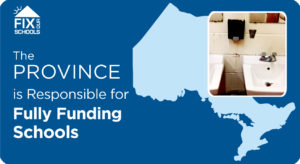
Fix Our Schools agrees with the view of Tranjan, Oliviera, and Robinson that, with political will to prioritize schools and education, our provincial government could easily afford to invest an additional $4.3-billion/year. As stated in the CCPA report, “when it comes to public education, we can afford to care: Ontario is a rich province in a rich country. The provincial government has the authority and the mechanisms to raise revenues to pay for the policies and programs proposed here, and more, if it so desires. Ontario spends less per capita on public programs than any other province in Canada. There’s room for improvement, for all of the right reasons: the students of today are the workers of tomorrow. The time to invest resources to help them catch up is now.”
Specifically, the CCPA report proposes that to fund further investment in Ontario’s schools and education system, the Province could:
- Review and undo some, or all, of the government’s recent tax changes, which would free up hundreds of millions of dollars for other priorities
- Increase the Personal Income Tax rate in a way that makes the overall system more progressive and increases taxes for those who are most able to pay.
- Reallocate dollars within the existing provincial infrastructure budget, for example by cancelling the proposed Highway 413, which the Globe and Mail has called “a $6 billion sprawl accelerator.”
IDEAS WORTHY OF DIALOGUE
Many thought-provoking ideas are considered throughout this report that deserve our thought, our debate, and our consideration. With less than four months until we head to the polls in Ontario to elect our next provincial government, Fix Our Schools hopes that all citizens will consider the criticality of publicly-funded schools and education to the future of this province and discuss, debate and consider the following ideas:
- “The people of Ontario have built one of the best education systems in the world. Ontario students have traditionally scored near the top in national and international rankings. Each generation leaves a better education system for the next. That’s the vision. That’s how it is supposed to work.”
- “Our schools are providing top-quality education while also fulfilling one of their fundamental roles: mitigating socio-economic inequality. The underlying rationale and expectation for public education systems is that they can serve as socio-economic equalizers, mitigating the inequities that follow students into the classroom. This is a core function of Ontario’s public schools, and one that is all the more relevant in the context of a global pandemic that affected—and continues to affect—lower- and higher-income families differently.”
- “Canada doesn’t perform as well in all spheres of learning and development. Among 38 wealthy nations, Canada ranks higher in children’s academic performance (18th), but lower in children’s mental health (31st) and physical health (30th). The 2020 UNICEF report card observed that “Canada’s public policies are not bold enough to turn our higher wealth into higher child well-being.”
- “At present, Ontario’s post-pandemic plan for public schools is to provide less money, bigger classes, and fewer resources to support children coming out of the pandemic. This plan will not equip schools to facilitate an equitable recovery, nor will it provide assistance to children and families who need it most. Ontario can do better. Much better.“
- “The benefits of quality education are widely recognized. For individual children, school opens doors to new worlds and new chances to be all that they can be. For society as a whole, school gives tomorrow’s workers the insight, skills, and creativity they will need to help us face the challenges of a future that grows more complex every day. Finally, education is the foundation of a productive, prosperous economy.”
- “The more we are able to provide quality education to all children—not just some of them—the better off we will all be. Public education is an investment that always pays off. Shoring up education spending should be a top priority for any provincial government, especially during this chaotic time.“
- “Underfunding education undermines the public system and widens the gap between haves and have-nots. It is biased public policy and if it continues, its unfortunate impacts will be felt for decades. Ontario can afford to do much, much better.”
- “Ontario is a rich province in a rich country. In 2019, prior to the pandemic, Ontario’s real Gross Domestic Product (GDP) per capita—a standard measure of general prosperity—hit a record level. In income terms, we were richer than ever in 2019, on average, than we had ever been before. What this means is that everything that Ontarians have built together in the past—from medicare to the community college system to the 400-series highways—was built at a time when we had less income, as a province, than we do now.“
- “COVID-19 or not, Ontario’s strong and diverse economy has the capacity to make significant new investments in the public school system and the well-being of our two million school children. The pandemic has had a surprisingly muted impact on provincial government revenues. While Ontario’s economy contracted sharply in 2020, massive federal spending to support individuals and businesses resulted in provincial revenues going up, not down. Despite pandemic lockdowns, combined revenues from Personal Income Tax (PIT) and Corporate Income actually rose by $5 billion from 2019–20 to 2020–21.”
- “There appears to be the political viewpoint that individuals are better placed to spend their money than governments. “The worst place you can give your money is to the government,” the premier said in October 2021. This may be true when it comes to buying shoes, but when it comes to paying for schools it is nonsensical. Public education is a social good and a social endeavour that falls squarely under provincial jurisdiction. The province needs to fund it, and fund it properly. The way to do that is to raise revenues through the tax system.“
- “The current government’s track record, and its campaign promises, are based on reducing revenues available to fund public services. When it comes to public education, such an approach hurts the long-term productivity of Ontario’s economy, increases inequality across socio-economic groups, and robs two million children of opportunities whose absence may be felt for a lifetime.“
- “If there is great wealth in Ontario—and there is—it is because decades of public investment have made it possible. Those who have benefited most from this investment have the greatest responsibility to repay it, for the good of all Ontarians and their children. Enhancing equity by revamping Ontario’s income tax regime is a fundamental step in funding public services to the standard that Ontarians expect.”
- “Given that in-class instruction is central to quality education, increased revenue to put Ontario’s schools in a state of good repair must be a central part of any plan to help Ontario students get their education back on track.“
- “In the last four decades, economies around the world have gone through a revolution, as business leaders and like-minded politicians have pushed market solutions to virtually every policy problem. There is no market-based solution to the problem of educational inequality. After the disruptions of COVID-19, Ontario’s public school system offers the only feasible route to getting learning back on track for all two million public school students.”
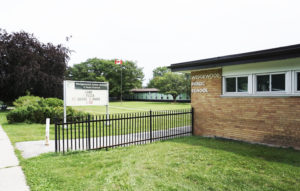 Etobicoke schools are still waiting for provincial funding for over half a billion in outstanding repairs — impacting HVAC systems, roofs, foundations & drinking water— despite many Ontario MPP’s signing a pledge to address this issue in the last election.
Etobicoke schools are still waiting for provincial funding for over half a billion in outstanding repairs — impacting HVAC systems, roofs, foundations & drinking water— despite many Ontario MPP’s signing a pledge to address this issue in the last election.![]()
![]()
 Hundreds of candidates signed the pledge and a full 58 of those signatories became Members of Provincial Parliament. Twenty-three Progressive Conservative MPP’s were signatories. In Etobicoke, both MPP Christine Hogarth and MPP Kinga Surma had committed to improve school conditions by bringing them up to an accepted standard by 2022.
Hundreds of candidates signed the pledge and a full 58 of those signatories became Members of Provincial Parliament. Twenty-three Progressive Conservative MPP’s were signatories. In Etobicoke, both MPP Christine Hogarth and MPP Kinga Surma had committed to improve school conditions by bringing them up to an accepted standard by 2022.


